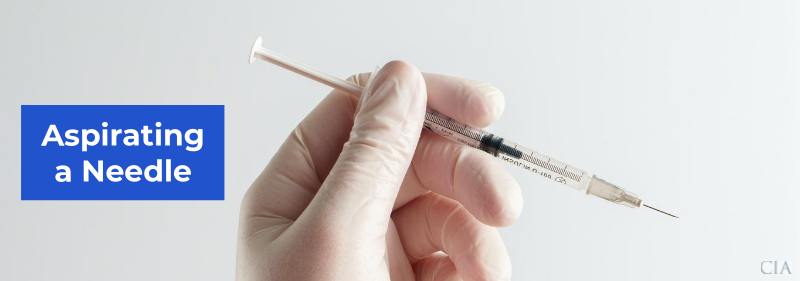

How to Aspirate a Needle Before an Injection (And Why It’s Done)
Countless injections are carried out every single day in hospitals and other healthcare settings all over the globe, and the practice of injecting medications and fluids into the body is a fundamental part of medical science.
However, there are still certain risks associated with injections and the usage of needles, and there are certain ways in which healthcare practitioners may choose to minimize those risks, like aspirating a needle before injection.
In this guide, we’ll explore what it means to aspirate a needle, why this is so important, the risks of not aspirating a needle prior to injection, and a step-by-step guide for how to aspirate a needle.
What Does It Mean to Aspirate a Needle?
So, what do we actually mean when we talk about aspirating a needle? Well, the verb “to aspirate” means to draw breath or air in. And when we aspirate a needle, we’re pulling the plunger up to potentially draw fluid in, rather than pushing it down to inject the medication out into the body.
The process essentially involves pushing the needle through the skin as normal, but then instead of immediately pushing the plunger down to release the fluid or medication, the user should pull the plunger up and hold it like that to create negative pressure for anywhere from 5 to 10 seconds. This is done as a safety measure.
You might also hear the phrase “aspirate on bone”, which simply means to aspirate a needle while it’s touching the bone. Aspiration can be carried out all around the body and for various kinds of injections, from intramuscular injections to subcutaneous injections.
Why Do You Aspirate a Needle Before an Injection?
The benefits of aspirating a needle are subject to debate among the medical community, but in general, a lot of experts agree that this process has one clear benefit: it allows the doctor or nurse to make sure that they are not inadvertently injecting fluid into a blood vessel.
When you aspirate a needle, you can see if any blood flows back into the needle hub. If so, this means that the tip of the needle has penetrated a blood vessel, and the injection should not proceed.
Injecting fluids directly into a blood vessel can be very dangerous and can lead to a range of unwanted effects, including nausea, dizziness, and even the possibility of a coma or sudden death for the patient.
Aspiration of needles is therefore done to minimize these risks. Even though the chances of a trained medical professional hitting a blood vessel are low, the risks are still present, and aspirating the needle helps to reduce those risks.
What Happens If You Don’t Aspirate a Needle?
If you do not aspirate a needle and proceed with an injection in an area where major blood vessels are present, there’s a risk that you could inject fluid directly into a blood vessel, which may lead to a range of unwanted effects for the patient. These effects can range from relatively mild issues like nausea to serious problems like comas and even death.
When to Aspirate a Needle
Aspiration is something of a hot topic in the medical world, and there are disagreements and conflicting arguments about whether or not aspiration is really necessary in some situations. In general, medical practitioners are advised to aspirate a needle before most intramuscular and subcutaneous injections. It’s worth noting, however, that guidance on aspirating can vary from one organization to another and is subject to change.
When to Not Aspirate a Needle
There are also situations in which there is no obvious need to aspirate. For vaccine injections, for example, which are usually performed in large sections of muscle in the arm or thigh, there’s no need to aspirate, as there is almost no risk of the needle entering a major vein or artery. In general, nurses and doctors do not need to aspirate when they do not believe that there is a considerable risk of hitting a blood vessel.
How to Aspirate a Needle
Now that we know the importance of aspirating before an injection, as well as the right times to aspirate and not to aspirate, let’s look at how the actual process of aspiration works. Here’s a simple, step-by-step guide for how to aspirate a needle before an injection:
- Identify the Injection Site – The first step of the process with any injection is to locate an injection site. Once the site has been found, it can then be cleaned and prepared, ready for the injection.
- Insert the Needle – The next step of the process is to insert the needle. Do this slowly and carefully in order to avoid any accidents or unwanted issues for the patient.
- Aspirate the Needle – Next, it’s time to aspirate the needle. With the needle inside the patient’s body, instead of pushing the plunger down to inject the substance, you should instead pull the syringe back a little for up to 10 seconds and watch for any sign of blood.
- Continue or Restart – If you see blood in the syringe, it means that you have hit a blood vessel and should not continue with the injection. Instead, you should remove the needle carefully and begin the process over with a new needle. If no blood enters the syringe, you should be able to continue with the injection.

